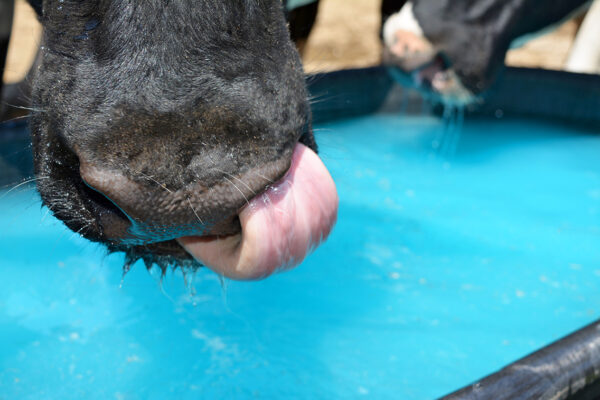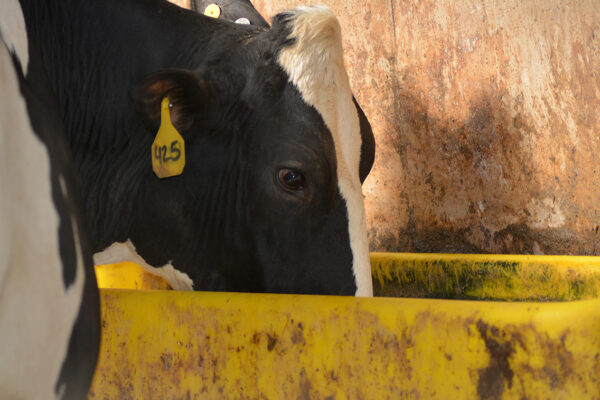Water quality: why it’s a big deal for dairy cows
By Nathan Upah
Michael Jordan had Gatorade, our children have PediaSure, but what about our cows? The creek, a pond, an automatic waterer? Dairy cow hydration is especially critical for production and reproduction, and effective management is more than just making sure there’s water in the tank.
A rumen is a large fermentation vat that contains well over 10 gallons of digesta (feed and water) at any point in time throughout the day. Which raises the question, “If the cow has water on board, is she ever truly dehydrated?”
Odds are, probably not from a clinical need standpoint. For instance, evidence based on blood hematocrit values suggests cows experiencing heat stress are super hydrated. Is hematocrit the right gauge to discern our cows’ hydration status? Some would suggest that as with calves, evaluating the orbital-socket-to-eye gap is the best way to assess hydration status of mature ruminants. Regardless of the method of hydration assessment, we know that stressful events in a cow’s life, such as changes in feed, freshening and heat stress, can turn the tables of metabolism – therefore, we can’t assume water is always efficiently transported and effectively used.

Why test water quality?
For some, the definition of effective hydration is wandering into pens to check the waterers to be sure the floats are not frozen. But when was the last time water quality was assessed at your farm? Perhaps the answer is when the well was originally drilled or the last time there was a problem with milk production. Either would likely be a top response in any social media poll.
Some may assume that the results from a water test one day are the same each and every other day, but sorry, nature is against you. The concentration of coliforms, contaminants, minerals, hardness, sulfur and nitrates are all changing as aquifer levels rise and fall, seasonal weather patterns fluctuate and even the neighboring land management practices change. For this reason, it’s recommended dairy producers test water seasonally.
Water quality metrics are recorded and assessed most commonly in parts per million (see Table 1). That means out of a million particles, five or less may be zinc, or 0.05 might be manganese, or less than 20 of them are nitrates. Peanuts, right? Wrong. The problem is two-fold. First, the tolerance level of imbalance is low in part because the cow consumes more water on a daily basis than any feedstuff. In fact, the water requirements of the dairy cow on a body mass index surpass that of any other land-based mammal, and the nutrient is second only to oxygen in importance for survival. Second, milk is 87 percent water, so it’s easy to calculate why water requirements are through the roof and also why a tiny imbalance can become a big problem.
Could water be part of a repro problem?
As we slowly crawl out of winter’s clutches, we joyfully anticipate the warmer temperatures of spring and summer. However, not too warm because that makes it hard to get cows pregnant. Traditionally, we have blamed heat stress for reproductive failures in hot summer months, and research has backed that up. But is heat really to blame for everything from lost production to reproductive failures? Or could some fault lie in what our cows are drinking?
During the spring and the hot summer months, lawns and crops are being fertilized and irrigated, and once soil is saturated, it has a very limited capacity to bind free water. Thus, contaminants that would normally be filtered out have the right of way on the express lane to leeching into the ground water supply. Nitrates are an example of a leeching issue. Once inside the rumen, nitrate is converted to nitrite, which in high concentrations enters the bloodstream and outcompetes oxygen to bind with hemoglobin. The bloodstream is responsible for supplying the embryo with 100 percent of its oxygen supply. If that oxygen supply is compromised, it can make pregnancy check day a less than enjoyable experience.

Further, cows consume exponentially more water during times of heat stress, so our risk for toxicity is elevated due to the season. This scenario is why water quality for pregnant humans is of significant concern, and the same should be true of our livestock. Embryonic development can be impacted by water quality – potentially to a lethal extent.
Water Sampling
Make water sampling part of a protocol, and when you sample your forages, also make a trip to the tap in the fresh pen. What you are looking for in a water test is not only the results of that test, but also a trend of relative sameness. Do we observe results that are similar each time we sample, or do our results vary wildly? We cannot exactly pinpoint where our water comes from. It is possible your water may be greatly impacted by the surrounding environment, while your neighbors’ may be far less variable; we don’t know until we sample and can establish a pattern.
Depending on the test results and what problems the farm is experiencing, the first stop is the nutritionist’s desk. The next step, depending on how wild the results are, would be resampling from multiple points on the farm.
Five important things to know about water quality on the farm:
-
-
-
Aquifer levels and nutrients change and require ongoing evaluation.
-
Contaminants can enter the water supply and affect health and production.
-
Heat-stressed cows drink more and can be more dramatically affected.
-
Water is critical to blood oxygen content, circulation volume and digestion.
-
Poor water quality can have a negative effect on pregnancy rates and fetal development.
-
-
The dairy cow is subject to her biology; she will make milk that is 87 percent water but cannot make milk that is 50 percent water one day and 95 percent water the next to offset water quality issues. Simply put, less water consumption means less milk. Water sampling and cleanliness protocols take minutes to do, and cost very little compared with the potential benefits. The real dollars can be found in what an operation is leaving on the table because they are not accounting for their animals’ largest nutrient requirement. Water is just as important for calves too.
Check water frequently. It may result in a simple dietary adjustment, or it could be as complex as a treatment system to get it under control. Abundance of clean, free-choice water is important, but that doesn’t mean we have the cow’s hydration potential covered. We must realize that just because the water is wet doesn’t mean it’s the same as it was yesterday.
Article first published on Progressive Dairy. Read it here.
